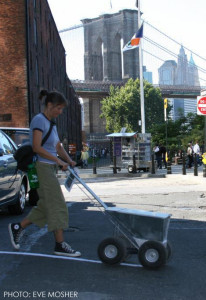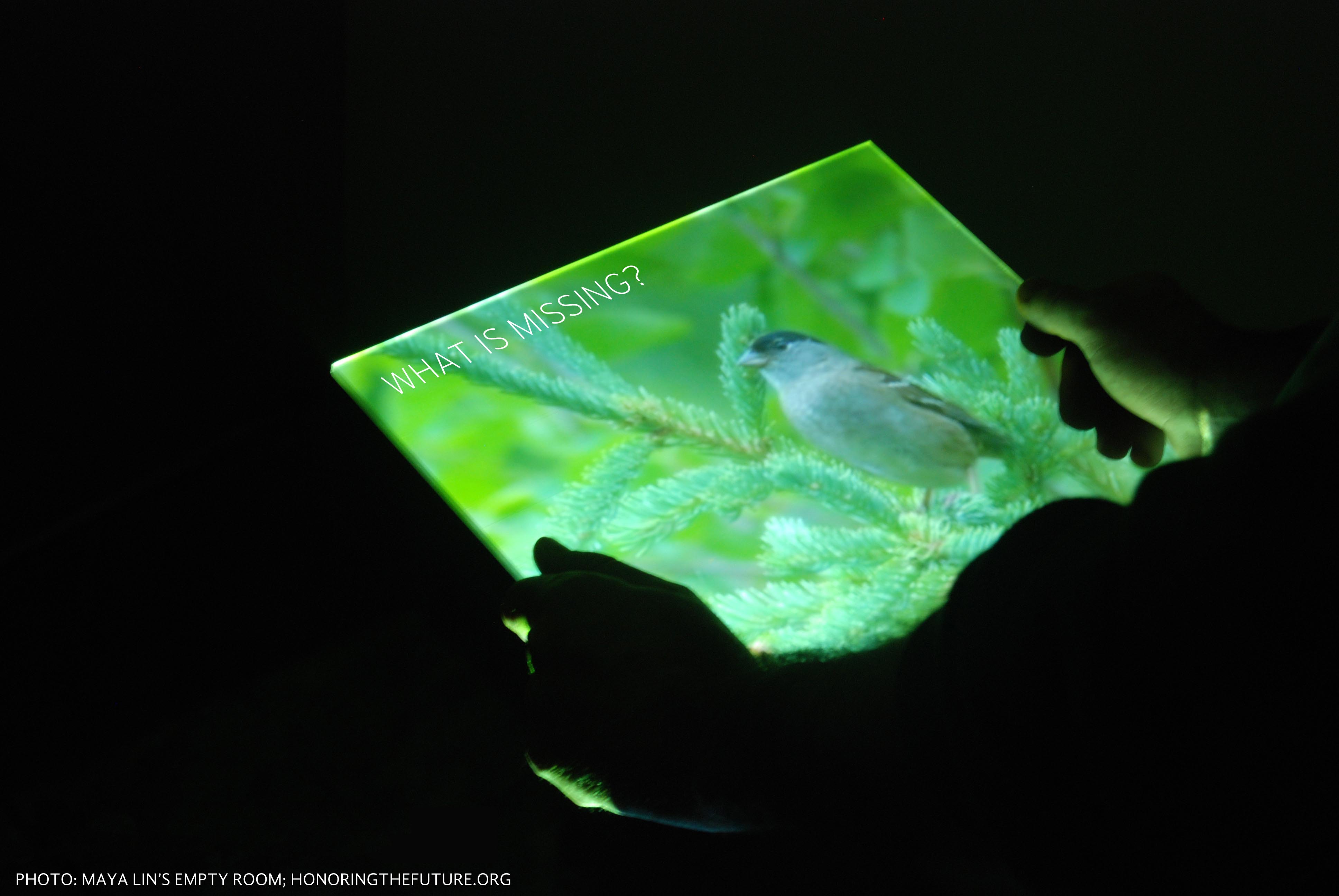By Christina Catanese, Director of Environmental Art
Bill McKibben wrote, in a 2005 essay on climate change and art, “But oddly, though we know about it, we don’t know about it. It hasn’t registered in our gut; it isn’t part of our culture. Where are the books? The poems? The plays? The goddamn operas?”
Climate change is abstract, cognitively complex, with no clear single villain; dialogue around climate change often induces self-defensiveness, the steps needed to respond require long time horizons, and many of the victims are distant, in either space or time. More so than many other environmental issues, climate change is a social as well as scientific challenge, making it even harder to wrap our minds around. For decades, climate scientists have tried to make their work resonate, but too often, the result is either data overload, or fear and warning of dire and disastrous consequences, which people tune out. Mounting evidence shows that our brains are simply not wired for this kind of abstraction – we respond subconsciously based on emotion, not data.
Luckily, artists are good at appealing to these parts of ourselves, with the ability to activate our imaginations, catalyze mindshifts, motivate change and action, and develop outside-the-box solutions.
McKibben may not have known about the groundswell of environmental art on climate change that was about to happen when he wrote that essay a decade ago. Today, climate change art is a force to be reckoned with, serving a critical role to help fill the gap in capturing imaginations, feelings, hearts, minds to motivate climate action. For one, at the COP21 negotiations this past December, a parallel event, ArtCOP21, was held – a range of art exhibitions, demonstrations, and events centered around climate action in Paris and across the globe.
Like a lot of communication about climate change, there has been a flurry of art about the arctic, rightly seen as ground zero of climate change impact and a barometer of what happens to the whole planet. Much of this artwork is darkly beautiful and striking, but I worry it has the same impact as that iconic stranded polar bear in a melting world – overwhelmed viewers may think, “This is too big and too hard and too sad, and in any case it’s happening far away in space and time. What can I do about this?” So I ask, how can art do better at engaging people? How can art help build relevance and motivate action around climate change?
Some artists are experimenting with art that itself has impact – visually compelling solar panels, sculptures that sequester carbon, large-scale landworks designed to help manage the more frequent and more intense stormwater we are likely to experience in the Philadelphia area. Many artists have moved away from more traditional art settings like galleries or sculpture parks, seeking to embed art works where people are likely to encounter them in their every day lives (Mary Miss’s City as Living Laboratory is in this vein).
 One stand out example to me is Eve Mosher, a Brooklyn-based artist who created HighWaterLine, a project where, using a map of projected sea level rise, she walked around New York City with a baseball field chalkliner marking what parts of New York would be under water if certain emissions scenarios become reality. As she was out in the public creating the work, Eve had a chance to engage in conversations about climate change and its potential impacts. Something so simple – a line on the ground that disappears with the next good rain – became an opportunity to understand local implications of climate change, making complex data visually comprehensible and personal. Mosher brought HighWaterLine to Philadelphia in 2014, and I had the privilege of drawing the line for a few blocks in Port Richmond, astonished by the rowhouses and infrastructure to the left of the line that could be impacted by increased storm surge and sea level rise flooding.
One stand out example to me is Eve Mosher, a Brooklyn-based artist who created HighWaterLine, a project where, using a map of projected sea level rise, she walked around New York City with a baseball field chalkliner marking what parts of New York would be under water if certain emissions scenarios become reality. As she was out in the public creating the work, Eve had a chance to engage in conversations about climate change and its potential impacts. Something so simple – a line on the ground that disappears with the next good rain – became an opportunity to understand local implications of climate change, making complex data visually comprehensible and personal. Mosher brought HighWaterLine to Philadelphia in 2014, and I had the privilege of drawing the line for a few blocks in Port Richmond, astonished by the rowhouses and infrastructure to the left of the line that could be impacted by increased storm surge and sea level rise flooding.
Making climate change personal is also deeply a part of Maya Lin’s What Is Missing project. The artist, famous for designing the Vietnam Memorial in Washington DC, calls it her last memorial – a crowd-sourced storytelling project where anyone can share their stories about species that will disappear, are disappearing, or have already disappeared. On a public website, anyone can share something they have personally witnessed changing, or view something they may not have been aware was disappearing. Lin sees this as a way to get around the trouble of shifting baselines, in which each successive generation accepts what they see as normal, not registering the gradual but persistent changes that are occurring. For the Philadelphia area, contributions to the map include citizen observations of diminished bat and bluebird populations, along with a historical account in the early 20th century of the then-plentiful sturgeon and shad in the Delaware River. A companion to the digital memorial is The Empty Room, a traveling exhibition I experienced a few years ago at Cornell University. The room is dark, with video projections coming out of the floor, which tell the stories of threatened but familiar species. But in order to watch the videos, visitors to the room have to grab a piece of plexiglass and position it over the projection, making it visible only so long as they held the plexiglass in place. Holding the animals in my own hands, I felt a sense of personal connection, and also responsibility.
That personal connection is key – drawing lines between global phenomena and what happens in our own lives and communities means the difference between despair and engagement. In one of my favorite recent writings about climate change, Zadie Smith wrote, “In the end, the only thing that could create the necessary traction in our minds was the intimate loss of the things we loved.” Art about climate change has a unique potential to make these problems personal and relevant, with artists able to serve in the role of commentator, collaborator, storyteller, catalyst, and more. Though both Mosher and Lin’s work have elements of loss, the end result for me is hope. Smith continues, “I found my mind finally beginning to turn from the elegiac what have we done to the practical what can we do.” Artists today have the unique potential to help more and more minds make this same, critical turn.


!!!